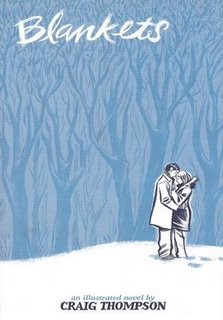I really didn’t know what to expect with Craig Thompson’s graphic novel Blankets. I became interested in Thompson after seeing his newest publication, Habibi, in the bookstore. And the reason I was interested was because I actually got Craig Thompson and P. Craig Russell confused. Russell does art and illustration for Neil Gaiman, especially his Sandman series, and so when I saw a graphic novel and the name “Craig” as the author/illustrator, I immediately did my Neil Gaiman connection (because I almost always do), and it wasn’t until I looked up Craig Thompson at home that I realized that I was thinking of the wrong person. But while I had confused the two, I ordered Blankets and I read it over the Christmas holidays.
Blankets is Craig Thompson’s autobiographical graphic novel, along the lines of Alison Bechdel’s Fun Home and Judd Winick’s Pedro and Me. Although it is a coming of age story and moves chronologically, Thompson chooses important moments to employ flashbacks and flash-forwards through his personal timeline. The novel details Thompson’s childhood and adolescence in an Evangelical Christian family, and Thompson particularly brings to life the farmhouse that he grew up in, especially the upstairs room that he shared with his younger brother Phil.
Thompson spends the majority of the “coming of age” detailing his relationship with Raina, a young woman the same age as him that he meets at a church camp one winter. Many of the illustrations are focused on capturing Raina, and Thompson details their conversations and letters and the things shared between them. Craig spends two weeks at Raina’s house during a winter vacation from school, and their parents drive both of them halfway in order to meet. Spending days and nights with Raina allows Craig to begin to form his understanding of love and connection, and the blanket that Raina makes for Craig seems to become the physical embodiment of what this stands for.
Another important facet of this novel is Craig’s relationship with his brother Phil. The juxtaposition between the childhood representations of Phil as he shares a bed with his brother, to Phil grown up and moved to his own place in the house is incredible, and Thompson seems to conceal more of this brotherly relationship than he reveals.
Thompson shows the intricacies of first love through autobiography. That this is his material and his experience is evident through the close, personal nature of the narration and illustration. It is a beautiful story that connects Thompson’s childhood with his adulthood, and presents his path towards creativity.





No comments:
Post a Comment